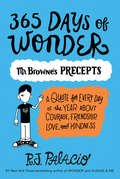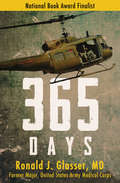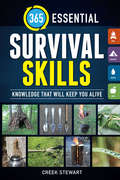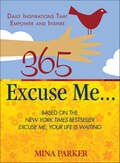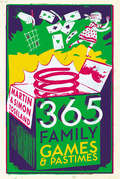- Table View
- List View
365 Days of Positivity: Daily Guidance for a Happier You
by Debbi MarcoThere’s joy in every day This little book will help you find everyday moments of happiness. With uplifting quotations and simple tips to brighten your mood, it will inspire you to stay positive all year round.
365 Days of Positivity: Daily Guidance for a Happier You
by Debbi MarcoThere’s joy in every day This little book will help you find everyday moments of happiness. With uplifting quotations and simple tips to brighten your mood, it will inspire you to stay positive all year round.
365 Days of Self-Care for New Mums: Advice for Surviving (and Thriving) in Baby’s First Year
by Zeena MoollaSelf-care for new mums is a necessity, not a luxury, so make sure you factor in me-time throughout baby’s first year with the help and advice in this bookMotherhood is a life-changing, magical experience, but it’s also a time in your life that’s emotionally charged and physically exhausting. Not only that, but you’re trying to care for a tiny human being who needs you 24/7. Self-care couldn’t be more important to you than it is right now.As you experience your first year of motherhood, let this little book be your helping hand from the early days to your child’s first birthday. Packed with tips and quotes, it offers quick, simple ways to help you look after yourself, covering a number of topics such as: Recovering from birthFeelings and relationshipsSleep deprivationConfidence and self-kindnessHealthy living for you and babyAvoiding the comparison trapYou deserve as much love and attention as you give, so let the advice in this book help you boost your well-being and feel like a fully functioning, confident new mum.
365 Days of Self-Care: A Journal
by Jayne HardyIt's one thing to understand how important self-care is, but how many of us actually manage to make the time do it?In 365 Days of Self-Care, CEO and founder of The Blurt Foundation, Jayne Hardy encourages you to take some time each and every day to be mindful, to check-in and prioritise the things that are truly important to you. This ebook edition contains: 365 daily prompts and trackers to note your moods, sleep and more; thoughtful mini-essays to prompt some deeper work; and check-in pages to help you see your progress - everything you need to get started on your self-care journey. Examples of daily prompts include:· Day 1: Boost· Day 52: Appreciate· Day 142: Rebel· Day 209: Thankful· Day 327: CourageWith the flexibility of choosing to start the journal anytime; on any day, in any year, this is the essential companion for bringing more self-care into your life.
365 Days of Self-Care: A Journal
by Jayne HardyIt's one thing to understand how important self-care is, but how many of us actually manage to make the time do it?In 365 Days of Self-Care, CEO and founder of The Blurt Foundation, Jayne Hardy encourages you to take some time each and every day to be mindful, to check-in and prioritise the things that are truly important to you. This ebook edition contains: 365 daily prompts and trackers to note your moods, sleep and more; thoughtful mini-essays to prompt some deeper work; and check-in pages to help you see your progress - everything you need to get started on your self-care journey. Examples of daily prompts include:· Day 1: Boost· Day 52: Appreciate· Day 142: Rebel· Day 209: Thankful· Day 327: CourageWith the flexibility of choosing to start the journal anytime; on any day, in any year, this is the essential companion for bringing more self-care into your life.
365 Days of Walking the Red Road
by Terri JeanMake a pilgrimage into your soul. . . 365 Days of Walking the Red Roadcaptures the priceless ancient knowledge Native American elders have passed on from generation to generation for centuries, and shows you how to move positively down your personal road without fear or doubt. Special highlights: Inspiring quotations from Native Americans, such as Tecumseh, Black Hawk, Geronimo, and Chief Joseph A monthly Red Road spiritual lesson The proper uses of dreamcatchers and other symbols and crafts Important dates in Native American history
365 Days of Wonder: Mr. Browne's Book Of Precepts
by R. J. PalacioIn the #1 New York Times bestselling novel Wonder, readers were introduced to memorable English teacher Mr. Browne and his love of precepts. Simply put, precepts are principles to live by, and Mr. Browne has compiled 365 of them--one for each day of the year--drawn from popular songs to children's books to inscriptions on Egyptian tombstones to fortune cookies. His selections celebrate kindness, hopefulness, the goodness of human beings, the strength of people's hearts, and the power of people's wills. Interspersed with the precepts are letters and emails from characters who appeared in Wonder. Readers hear from Summer, Jack, Charlotte, Julian, and Amos. There's something for everyone here, with words of wisdom from such noteworthy people as Anne Frank, Martin Luther King Jr., Confucius, Goethe, Sappho--and over 100 readers of Wonder who sent R. J. Palacio their own precepts.
365 Days of Yoga: Daily Guidance for a Healthier, Happier You
by Summersdale PublishersInhale calm, exhale your cares...Find inspiration for your yoga practice every day with this book of uplifting quotations, mindfulness techniques and step-by-step guidance on the best-loved yoga poses to engage and energize both mind and body all year round.
365 Days of Yoga: Daily Guidance for a Healthier, Happier You
by Summersdale PublishersInhale calm, exhale your cares...Find inspiration for your yoga practice every day with this book of uplifting quotations, mindfulness techniques and step-by-step guidance on the best-loved yoga poses to engage and energize both mind and body all year round.
365 Days: 50th Anniversary Edition
by Ronald J. GlasserNational Book Award Finalist: The Vietnam War as seen through the eyes of an army doctor—&“a book of great emotional impact&” (The New York Times). In 1968, as a serviceman in the Vietnam War, Dr. Ronald Glasser was sent to Japan to work at the US Army hospital at Camp Zama. It was the only general army hospital in Japan, and though Glasser was initially charged with tending to the children of officers and government officials, he was soon caught up in the waves of casualties that poured in from every Vietnam front. Thousands of soldiers arrived each month, demanding the help of every physician within reach. In 365 Days, Glasser reveals a candid and shocking account of that harrowing experience. He gives voice to seventeen of his patients, wounded men counting down the days until they return home. Their stories bring to life a world of incredible bravery and suffering, one where &“the young are suddenly left alone to take care of the young.&” An instant classic of war literature, 365 Days is a remarkable, ground-level account of Vietnam&’s human toll.
365 Days: A Novel (365 Days Series #1)
by Blanka LipinskaNow a hit Netflix film!The sexy and deeply romantic internationally bestselling novel that inspired the blockbuster movie. Laura Biel and her boyfriend are on a dream vacation in beautiful Sicily. On the second day of their trip, her twenty-ninth birthday, she is kidnapped. Her kidnapper is none other than the head of a powerful Sicilian crime family, the incredibly handsome, young Don Massimo Torricelli, who is determined to possess her at all costs. Massimo has his reasons. During an earlier attempt on his life, a vision appeared before his eyes: a beautiful woman, identical to Laura. After surviving the attack, he vows that he will find the woman in his vision and make her his own. No matter what. For 365 days, Massimo will keep Laura captive in his palatial estate and attempt to win her heart. If she doesn&’t fall in love with him during this time, he will let her go. But if she tries to escape at any point, he will track her down and kill her entire family. Soon Laura develops a fascination with her handsome and powerful captor. But as a precarious, risky relationship forms between them, forces outside their control threaten to tear them apart...
365 Devotions for Finding Rest (365 Devotions)
by Christina VinsonIn a busy, busy world, everybody is looking for ways to unplug and find time to rest—but it has become a lost art to many of us. This devotional helps you set aside time to calm your mind and refresh your soul with the peace of God. God never designed His people to live in the hurrying, scurrying reality of our daily lives. His plan always included rich times of rest, full of depth and peace and the chance to reconnect with Him. 365 Devotions for Finding Rest offers you a chance to find that place with the Lord, to take a few minutes out of every day to encourage your heart, and, in such, find the rest your weary heart longs for. Full of calming, inspirational devotions, 365 Devotions for Finding Rest invites you to examine your life and rediscover what true, biblical rest could look like for you. In easy-to-understand language and simple formats, this devotional offers a daily dose of the rest and peace without any guilt attached. Come and find what Jesus truly meant when He said, “I will give you rest.” His words will fill you with strength and understanding for the busy times of life and will offer the wisdom you need to slow down and truly rest. Whether you’re looking for an excellent way to encourage a frazzled friend or a first step toward easing your own over-scheduled heart, 365 Devotions for Finding Rest has a place on every bookshelf, just as its message has a place in every life.
365 Devotions for Hope
by Karen Whiting365 Devotions for Hope shares the simple but profound message that when we know God, we are filled with hope, peace, and fulfillment directly from Him. Daily devotional readings paired with beloved quotes and Scripture passages will lead you to the glorious hope that spills out from God’s love. Each day will bring new inspiration to rise above circumstances, focus on truth, and celebrate hope and security in your faith. Whether you are a new believer or a Christian in need of renewed hope, you will be encouraged to live out your faith with confidence as you learn more about God’s faithfulness.
365 Devotions for Living Joyfully: Daily Encouragement for a Joyful Heart (A 365-Day Devotional) (365 Devotions)
by Victoria Doulos YorkTransform your life when you discover the power of joy each day of the year.Discover the joy of the Lord in fresh ways through the beautiful new 365 Devotions for Living Joyfully. Full of simple, accessible devotions for every day of the year, this book will help you find deep, unshakable, biblical joy and will inspire you to live your most joyful life.God never meant you to move through your days in joyless routine. Yet in the midst of busy schedules and endless to-do lists, joy seems like a luxury few can afford. But there is hope! You can cultivate a deep, lasting, holy joy that burns steadily within you, no matter what you might face. So, take heart and refresh your soul every day of the year through the encouraging words of 365 Devotions for Living Joyfully.In 365 Devotions for Living Joyfully you are invited to take a few minutes each morning to rekindle this biblical understanding of a joy-filled life. As you reflect on the abundant life God offers you will rediscover how joy can transform your heart. These devotions will inspire and grow your faith as you begin to see life as God truly intended it—full of abounding joy! Each daily entry features a:Scripture verse to help you start your day in God's WordDevotional reflection to help you meditate on the joy that God offers you each dayPrayer to help align your heart with God 365 Devotions for Living Joyfully invites you to spend a few moments meeting your loving God every day and seeking His joy. This devotional will guide you through a yearlong journey toward a transformed, joyful heart that overflows into the lives of those around you. The more you learn about God's promises and desires for you, the more you'll say with the psalmist, &“My heart trusts in him, and he helps me. My heart leaps for joy, and with my song I praise him&” (28:7).
365 Devotions for Peace (365 Devotions)
by Cheri Cowell365 peaceful days add up to a life-changing year. This affordable daily devotional walks readers through the peace that comes from knowing God in a simple and accessible format. Each entry focuses on ways God offers peace, how to let go of stress and panic and let God guide you, and how to hold onto peace even in the most stressful and hectic of times. Sample excerpt: “The world was dark. For 400 years God had been silent. Not a word. Not a peep. Had he forgotten his people? Did he no longer hear their cries? Then the most incredible thing happened. The heavens broke forth in praise. Shepherds shouted their joy, and that joy reverberated over the mountains. The Lord had heard their cries. He has heard yours and has come to comfort. He brings comforting peace into this dark world, peace into your world. Are you in need of comfort and peace? He has come for you.”
365 Devotions for Women
by Sally D. SharpeStrengthen your bond with God, one devotion at a time.As women, we have many roles and responsibilities. We are daughters, sisters, wives, mothers, stepmothers, grandmothers, caregivers, working women, leaders, teachers, pastors, and pastors’ wives, neighbors, friends—and the list goes on. Yet in all of these roles, we bring a special gift that God has given us: the gift of nurturing—helping others feel loved, appreciated, and capable of achieving all they are meant to be.We, too, however, need nurturing. Often, we forget or ignore this fact, finding ourselves overextended and drained after giving all we have without taking time for our own needs. Our lives tend to be busy, hectic, and sometimes even frenzied, leaving little time for ourselves or God. Yet God longs to wrap loving arms around us and give us rest, encouragement, hope, strength, peace, and joy. God is the only One who can fill us and make us whole.365 Devotions for Women is written to help you focus on your relationship with God. Twelve different Christian women share their reflections on what it means to be a woman of faith, walking with God day by day. As you go through the year (whether you start in January or June), encountering a different writer each month, you will find spiritual refreshment and a sense of camaraderie for the challenge of giving your relationship with God the time and attention it deserves. Though these women have diverse backgrounds, personalities, and ways of relating to God, they have a common theme: God loves you and longs to be in relationship with you.The contributors are Nell W. Mohney (January), HiRho Park (February), Cynthia Gadsen (March), Kelly Clem (April), Lillian C. Smith (May), Nancy Nikolai Shedden (June), Anne Hagerman Wilcox (July), Marie Schockey (August), Hilda Davis (September), Sallie Dye (October), Monica Johnson (November), and Ellen Gray (December)Begin today to nurture your relationship with God. It’s the most important nurturing of all!
365 Devotions for a Thankful Heart (365 Devotions Ser.)
by ZondervanNo matter how difficult life seems, you will find more joy when you choose gratitude. Boost your happiness and deepen your walk with God by becoming aware of all you have to appreciate. 365 Devotions for a Thankful Heart is a daily devotional that will inspire you to slow down, recognize God&’s gifts, and be grateful for all His blessings.This yearlong devotional includes:a short daily reading encouraging you to open your heart with gratitude to all the ways God has blessed youan inspiring Scripture and a short prayer to help focus your heart on thankfulness as you go about your dayWith a foiled cover and beautiful interiors, this devotional is a perfect gift for women of all ages on birthdays, Valentine&’s Day, Mother&’s Day, Christmas, or as a welcoming gift for new church members. Each devotion is the perfect length to fit into even the busiest schedule, but substantial enough to start your day on just the right note.
365 Devotions to Embrace What Matters Most: Rediscover Joy and Passion in Your Life (A 365-Day Devotional) (365 Devotions)
by John MichalakReclaim your passions, your relationships, and your joy through daily reminders of what really matters.365 Devotions to Embrace What Matters Most invites you to uncover the essence of a meaningful life. This daily devotional companion offers you practical and heartfelt insights to focus on life's most valuable treasures—love, purpose, and relationships. It speaks to your soul, reminding you to live fully engaged and wide awake.Life is a precious gift, yet the grind of daily demands can cloud your vision, making life feel like a never-ending cycle of obligations. From appointments to grocery shopping, we can get bogged down in busyness and end up sleepwalking through life, completely missing the beauty and wonder all around. But it is never too late to live the wide-awake, passionate life you long for.365 Devotions to Embrace What Matters Most invites you to reclaim your passions, your relationships, and your joy through daily reminders of what really matters. Each page offers you accessible yet profound insights for how to make small but meaningful changes—prioritizing rest, practicing humility, giving generously, or simply regaining wonder for God's creation. This devotional will gently guide you to become the kind of person you want to be, living deliberately and grasping the eternal beauty in the present moment.Each daily entry features a short but profound meditation that will guide you to reflect on your life and the world around you, along with a Scripture verse to help you ground your heart and mind in God's Word. For a few moments each day, spend a little time meditating on the things that matter:Who you are, why you're here, and what you should do about it.How you see the world.How to free yourself from the rat race.The importance of your relationships.What's wrong and how to make it right.How to become a better human being 365 Devotions to Embrace What Matters Most gives you daily reminders that life is precious and beautiful. Whether you long for rest, deeper connections, or a renewed sense of meaning, this devotional empowers you to pause, reflect, and walk a path rich with purpose and delight. Get ready to embrace what really matters most, and start living with intention, wonder, and joy!
365 Devotions to Love God and Love Others Well (365 Devotions)
by ZondervanIn our culture, where social media "friends" trump real-life relationships, people have never been more isolated and lonely. 365 Devotions to Love God and Love Others Well helps us experience God's perfect love for us and enables us to love others in a meaningful, honest, and profound way.Everyone wants to love and be loved, but we lack the time and the intentionality to forge lasting relationships. We go about our days feeling battered and broken, lonely and solitary, despite the fact that we've been relentlessly adored by our Creator. This devotional gently shares with us that God already calls us beloved, and He desires that we love others just as He loves us.365 Devotions to Love God and Love Others Well reminds you daily that in God's eyes you're priceless beyond measure, and your intrinsic value doesn't change one bit regardless of what kind of day, week, or even year you’re having. God has called you irreplaceable. This is the love He has for you and the love He has called you to extend to those around you. Savor this yearlong journey into God's limitless and far-reaching love.
365 Easy One Dish Meals
by Natalie HaughtonA year's worth of simple, sumptuous recipes that are hassle free--minimizing cooking and clean-up; maximizing variety and appeal. Everything from hearty beef borscht to spicy Thai chicken noodles.
365 Energy Boosters: Juice Up Your Life, Thump Your Thymus, Wiggle as Much as Possible, Rev Up with Red, Brush Your Body, Do a Spinal Rock, Pop a Pumpkin Seed
by Sondra Kornblatt Susannah SetonA year’s worth of tips and techniques to stop dragging your feet—and start getting things done! “A catalyst for personal empowerment.” —Brian Luke Seaward, Ph.D., author of Stressed is Desserts Spelled BackwardAre you tired of being tired? As we put untold amounts of pressure on ourselves to perform, to keep a spotless home, to have the perfect relationship, the most well-behaved kids, and the best job, the constant need to be productive is wearing us out, physically and emotionally.In 365 Energy Boosters, Susannah Seton and Sondra Kornblatt provide us with a daily guide for putting an end to the madness, embracing a new and improved life experience, and getting a big dose of energy to boot. You’ll find energizing one-minute exercises and foods for a quick pick-me-up and learn ways to track your natural energy cycles, get organized, sleep better, and wake yourself up whenever your energy takes a nosedive. Make these tips and techniques the first item on your to-do list—and the rest of the day can become easier than ever.
365 Essential Survival Skills: Knowledge That Will Keep You Alive
by Creek StewartLearn. Practice. Prepare. Survive. Survival situations can happen when least expected. The best defense is knowledge and confidence in the skills that will keep you alive--whether it's for a few hours, days or long term.365 Essential Survival Skills comprises the best knowledge, tips and tricks available in the world today, and each skill is explained in fun, easy-to-learn ways that any student--greenhorn or seasoned--will pick up with a little practice. With 365 skills inside this book, there's plenty of practice to keep you busy year-round. The difference between life and death in a survival setting is a very slim margin. Don't take any chances--learn how to keep yourself and your family alive. FEATURING:Skills relevant to all four seasons of the year and desert, woodland, prairie, mountain and urban environmentsVital insights on the four core survival needs--shelter, fire, water and foodOther topics such as navigation, first aid, tools, signaling, self-defense and morePractical applications for campers, hunters, anglers, hikers, climbers, skiers and all who venture outdoorsLinks to thorough, in-depth video demonstrations
365 Excuse Me . . .: Daily Inspirations That Empower and Inspire
by Mina Parker365 Excuse Me... is for the hundreds of thousands of fans of the Law of Attraction who want more help incorporating its teachings into their daily lives.Inspired by Lynn Grabhorn's bestselling Excuse Me, Your Life Is Waiting, 365 Excuse Me... contains 365 empowering meditations to help readers live the Law of Attraction and embrace the possibilities that life offers every day.Each day's meditation has three parts:A quote from Lynn GrabhornA charmingly told anecdote or teaching storyA personal goal for the dayLynn Grabhorn wrote: "Didn't you ever feel that there's some secret part of you that knows everything there is to know but just doesn't stick its head out? There is."365 Excuse Me... offers readers the motivation and inspiration to find the secret part in themselves to live the Law of Attraction every day of the year.
365 Family Games and Pastimes
by Simon Toseland Martin ToselandRemember Blind Man's Bluff, Pin the Tail and Murder in the Dark? Making daisy chains and collecting conkers? And when rainy afternoons meant card games and battleships? Jam-packed with games and activities for all ages, 365 Family Games and Pastimes remembers all the classics we used to love, bringing them back for the entire family to enjoy.Full of inspiration and thrifty ideas, this is an indispensible collection for birthday parties, family holidays and everyday fun.
365 Fascinating Facts About Israel
by Clarence J. WagnerWritten from the unique perspective of one American who has made Israel his home for 22 years, this remarkable compilation gives you a bird's eye view of the Middle East, its people and customs. You'll get unique glimpses into the lives of both Jews and Arabs, and marvel at the power of a region claiming Hebron, Bethlehem, Haifa, Tel Aviv, the Golan... and, of course, that City on a Hill, Jerusalem. Packed with a wealth of information about "Eretz Israel," the Land of Israel, 365 Fascinating Facts about Israel brings the region to life, especially for those who have never been there. From general information about climate, culture, and customs, to concise information about Middle East politics, wars, and efforts for peace, this book is the only handbook you need to understand this magnificent land. Add to your knowledge with such facts as the following: "Palestine" was a word coined by the Roman Empire after the time of Christ. Israel today is a leading exporter of flowers, fulfilling the prophecies that the region would again bloom after God regathered the Jews from their worldwide dispersion. Jerusalem is located in Judea, an area today known to many as the "West Bank." Modern Israel, over 50 years old, is barely younger then neighboring states Jordan, Syria, and Iraq. The Holy Land is bordered on the west by the Mediterranean sea, and on the right by the Jordan River.




